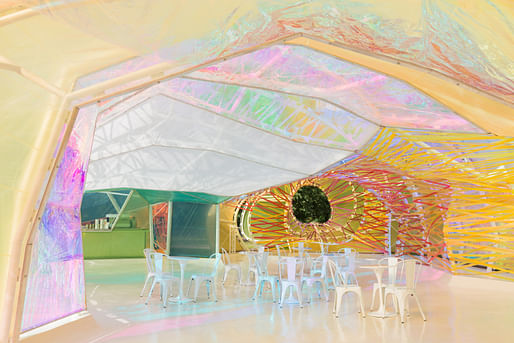
A sea of canary yellow office pods is taking shape on a dusty lot off of Sunset Boulevard in Los Angeles. There, Spanish architects Selgascano and global co-working platform Second Home are busy finishing out the group’s new 90,000-square-foot Hollywood outpost, a mesmerizing construction site brimming with unusual architecture.
While touring the site, Second Home co-founder Rohan Silva explains the basic premise behind the budding social-business venture: “We want to put creative people together and help them do great work.”

That vision guides the architectural design of the complex as well as the company’s business plan. The site, arranged in two opposing configurations, mixes old and new, formal and ecstatic, staid and colorful. At the front of the complex, for example, an existing 1960s-era Paul Revere Williams-designed building that once housed a local chapter of the Assistance League of Southern California is being repurposed into a collection of ground floor community arts spaces. Anchored by a central courtyard that will be stuffed with trees, the venue’s generous and highly-adaptable peripheral spaces are designed to have multiple activities going on at once and to function across the day and night. The group plans to have these shared spaces open to the community on a walk-in basis, a configuration at odds with many of the other recently-opened or on-the-way membership-based arts clubs in the area. The building is set to contain a small theater, recording studio, restaurant, bookshop, and other event spaces on this level, with professional meeting spaces here available for use by community groups free of charge.
Silva and his partner and co-CEO Sam Aldenton explain the project as a venture fueled by a mix of alchemy and hope, a place, like other projects the two have worked on independently, that will become vital the second it comes online. How will that happen, exactly? Through heavy use, of course. Aldenton explains that the major challenge of the project is making the spaces available to as many people for as long as possible. “How do we get the most out of the building?” Aldenton asks, “If we can find a way to activate the building for 18 to 20 hours per day, that’s a great thing.”

To create the necessary revenue stream that will fuel the enterprise, Second Home will offer 30 interior studios on the second floor of the Revere-Williams building, spaces designed with minimal enclosures and direct access to a series of new rooftop terraces. Eventually, the roofdeck will run directly into the space, creating an indoor-outdoor working environment overlooking a sea of yellow-roofed office pods.
The impossibly bright single-story pods, organized in tight clusters all around the back half of the site, contain 60 individual offices outfitted with wrap-around desk seating, central meeting tables, and clear-span interiors. The pods represent the first use of cross-laminated timber in California, according to the architects, a material choice that allows for each office to offer uninterrupted interior space. Each pod will be partially submerged by a raised bed, as well, a configuration that will cut down on heating and cooling requirements while also providing a type of inverted open-office arrangement where each workstation faces outward toward a wall of lush plants.

Aldenton explains that the site will feature 6,500 trees and plants, an impossible number based on the size of the relatively small lot. Renderings for the project depict palm trees and ferns bursting between the office pods, hanging plants cascading from the ceilings, and an orchards’ worth of flowering trees growing out of formica tabletops in the courtyard and other outdoor spaces.
The project, nearly completed and due to open in early September, is not the only public arts-focused venture Second Home and Selgascano have in store for Los Angeles, however.

The two teams have also partnered with the Natural History Museums of Los Angeles County to bring Selgascano’s 2015 Serpentine Pavilion to the city’s La Brea Tar pits. The blobby, multi-colored installation will “offer the public a flexible, multi-purpose social space in which to enjoy public programs and events focusing on the intersection of art, design, science, and nature,” according to a press release.
Designed by Selgascano for the Serpentine Gallery’s Hyde Park site, the 866-square foot pavilion is made of multi-colored fabric membranes that allow color, shape, and light to pass through, creating a multi-faceted experience inside and out. Inside the space, light becomes dyed by the fabric as it passes through, filling the space with a “bright stained-glass effect,” according to the architects.
The pavilion is set to debut on June 28th.
1 Comment
Awesome. Second home in London is brilliant. The serpentine pavilion was the one I thought I wouldn’t like but it is probably still my favorite in the last few years. I love the feeling that everything is carefully made but entirely un-precious. Slightly junky but not junk. It gives permission to be completely human.
Block this user
Are you sure you want to block this user and hide all related comments throughout the site?
Archinect
This is your first comment on Archinect. Your comment will be visible once approved.